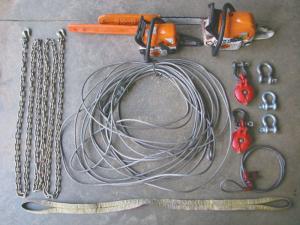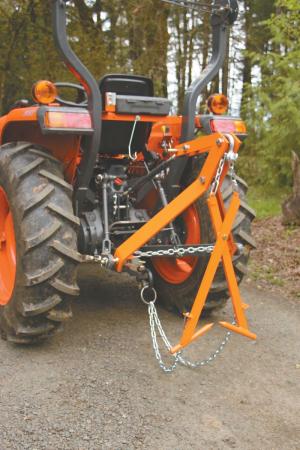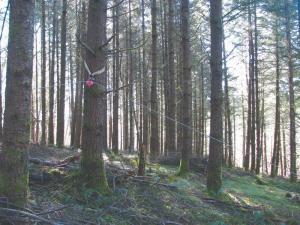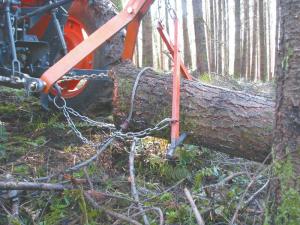How To Profit From A Small Woodlot
If you have a woodlot that needs to be harvested or thinned but it’s too small to interest a commercial logging company, you can do it yourself and turn a profit, says Tom Repko of Dallas, Ore. In a week’s time he cut down, skidded, bucked and stacked a semi-load of Douglas fir logs that were 10 to 15-in. dia. on the stump. Altogether, he ended up cutting down enough for 5 loads and averaged $1,400/load from a local mill. He ended up with $1,150 after paying $250/load to the trucker. After taking out fuel and oil expenses for his tractor and chainsaw, Repko figures he earned about $27/hour.
One piece of equipment that made the job easier was the Cat. I 3-pt. hitch log skidder Repko invented and sells ($500). It was featured in FARM SHOW’S Vol. 39, Issue 3.
Operated from the seat of a small horsepower tractor, the skidder has scissor tongs with 1-in. spikes that grip the log so it can be lifted with the hitch, moved and then dropped.
Repko and his wife attended many workshops and classes about managing their 40-acre woodlot. After learning that loggers weren’t interested in taking on such a small job, Repko gathered simple equipment to tackle the job: his 38 hp. Kubota L3800 tractor fitted with his 3-pt. skidder; a small Stihl chainsaw (MS180 with an 18-in. bar) for limbing; and a bigger Stihl saw (MS311 with 25-in. bar) for felling; personal protective gear; sledge hammer and wedges; and a 200-ft. 1/2-in. cable with snatch blocks and choker to move logs off sloped areas of his woods.
“On the steep hillsides I hung the snatch block as high as I could get it (on a spar tree) to provide as much lifting as possible. When necessary I used additional snatch blocks and slings set low around anchor trees to provide directional control of the log being pulled,” Repko says. “I found that nylon sling straps are easier to work with and much less likely to damage the spar tree or slide down the tree while under a load.”
He notes that one advantage of cutting his own trees was that he took his time and paid attention so he didn’t scar standing trees when pulling out logs.
“I found the most time consuming part of this project was selecting which trees to cut. A professional forester making those selections would certainly be an asset, but at a cost,” Repko says. But his choices of ice-damaged trees and trees with multiple tops proved to be correct. All had 2 to 8 ft. of core rot.
With about 70 logs per load, Repko estimates he has another 3 or 4 loads to remove when weather permits.
“I have been retired now for three years, and I can’t remember when I last felt so gratified after doing a project as I do now,” he says. “The message I hope to deliver is that if you own a small forest land that you wish to manage for timber, or simply maintain it as a healthy forest, and you are willing to take the time and do the work, you can do the work yourself and put some money in your pocket.”
Contact: FARM SHOW Followup, Tom Repko, Small Wood Lot Tools, LLC, 2080 Cherry Knoll Rd., Dallas, Ore. 97338 (ph 503 949-2209; www.smallwoodlottools.com; sales@smallwoodlottools.com).

Click here to download page story appeared in.
Click here to read entire issue
How To Profit From A Small Woodlot SPECIALTY/SERVICES If you have a woodlot that needs to be harvested or thinned but it’s too small to interest a commercial logging company you can do it yourself and turn a profit says Tom Repko of Dallas Ore In a week’s time he cut down skidded bucked and stacked a semi-load of Douglas fir logs that were 10 to 15-in dia on the stump Altogether he ended up cutting down enough for 5 loads and averaged $1 400/load from a local mill He ended up with $1 150 after paying $250/load to the trucker After taking out fuel and oil expenses for his tractor and chainsaw Repko figures he earned about $27/hour
One piece of equipment that made the job easier was the Cat I 3-pt hitch log skidder Repko invented and sells $500 It was featured in FARM SHOW’S Vol 39 Issue 3
Operated from the seat of a small horsepower tractor the skidder has scissor tongs with 1-in spikes that grip the log so it can be lifted with the hitch moved and then dropped
Repko and his wife attended many workshops and classes about managing their 40-acre woodlot After learning that loggers weren’t interested in taking on such a small job Repko gathered simple equipment to tackle the job: his 38 hp Kubota L3800 tractor fitted with his 3-pt skidder; a small Stihl chainsaw MS180 with an 18-in bar for limbing; and a bigger Stihl saw MS311 with 25-in bar for felling; personal protective gear; sledge hammer and wedges; and a 200-ft 1/2-in cable with snatch blocks and choker to move logs off sloped areas of his woods
“On the steep hillsides I hung the snatch block as high as I could get it on a spar tree to provide as much lifting as possible When necessary I used additional snatch blocks and slings set low around anchor trees to provide directional control of the log being pulled ” Repko says “I found that nylon sling straps are easier to work with and much less likely to damage the spar tree or slide down the tree while under a load ”
He notes that one advantage of cutting his own trees was that he took his time and paid attention so he didn’t scar standing trees when pulling out logs
“I found the most time consuming part of this project was selecting which trees to cut A professional forester making those selections would certainly be an asset but at a cost ” Repko says But his choices of ice-damaged trees and trees with multiple tops proved to be correct All had 2 to 8 ft of core rot
With about 70 logs per load Repko estimates he has another 3 or 4 loads to remove when weather permits
“I have been retired now for three years and I can’t remember when I last felt so gratified after doing a project as I do now ” he says “The message I hope to deliver is that if you own a small forest land that you wish to manage for timber or simply maintain it as a healthy forest and you are willing to take the time and do the work you can do the work yourself and put some money in your pocket ”
Contact: FARM SHOW Followup Tom Repko Small Wood Lot Tools LLC 2080 Cherry Knoll Rd Dallas Ore 97338 ph 503 949-2209; www smallwoodlottools com; sales@smallwoodlottools com
To read the rest of this story, download this issue below or click
here to register with your account number.










